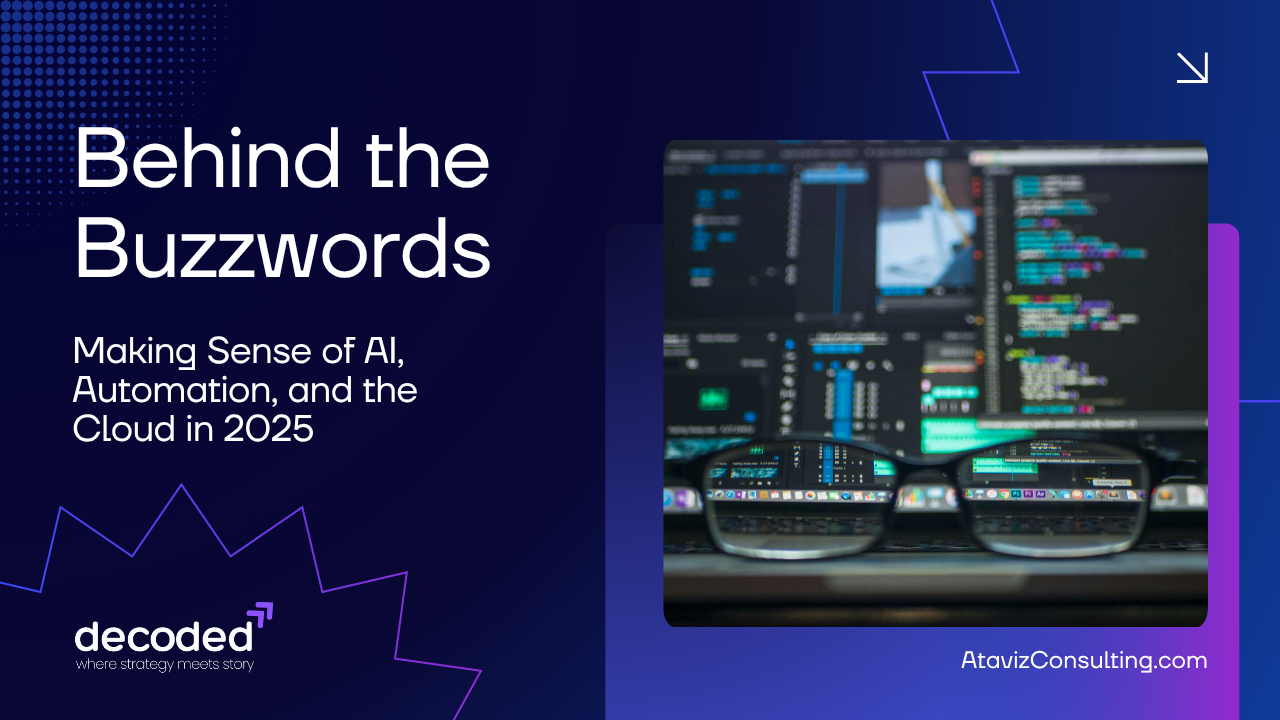
Behind the Buzzwords:
Making Sense of AI, Automation, and the Cloud in 2025

June 4, 2025
By Nicholas Johnson, Founder of Ataviz Consulting
Let’s be honest—if you’re a business leader in 2025 and you still don’t fully understand what AI, automation, and “the cloud” actually mean for your company, you’re not alone.
These terms have been tossed around so often, and so vaguely, that they’ve started to lose their meaning. Vendors use them to justify bloated software proposals. Consultants throw them into pitch decks to sound futuristic. And most executives nod along, hoping no one asks them to explain the difference between machine learning and marketing automation in a meeting.
So today, we’re cutting through the noise.
Automation ≠ AI (and Neither Replace Your Team)

Too many people use “automation” and “AI” interchangeably—but they’re not the same:
- Automation is about streamlining repeatable tasks. Think: auto-generating reports, sending customer follow-ups, syncing CRMs, or moving data from one system to another. It’s logic-based, rule-driven, and should always be measurable in time saved or errors reduced.
- AI, especially modern generative AI, involves systems that learn from data to make predictions, categorize inputs, or generate outputs (like text or images). Think of it as a digital intern who never sleeps, but still needs supervision.
If automation is your process plumber, AI is your creative assistant. Most businesses can benefit from both—but very few need to build a full AI stack.
The Cloud Is Just… Someone Else’s Computer (Sort Of)

By now, you’ve probably moved at least some part of your tech stack to the cloud. But cloud isn't magic. It’s infrastructure. It’s storage. It’s access. It’s flexibility.
And more importantly—it’s risk management.
Cloud migration in 2025 is less about saving space on local servers and more about scalability, redundancy, and accessibility. When done right, it lets small teams act big and big teams move fast. When done wrong? You’re paying for a cluttered garage in the sky.
Buzzwords Become Traps When They Replace Strategy

Here’s the hard truth: Implementing AI, automation, or cloud systems without a clear business use case is the modern-day equivalent of buying gym equipment to “get in shape” without a workout plan.
You don’t need a chatbot because your competitor has one. You don’t need an AI strategy because LinkedIn said so. You need solutions that:
- Save time
- Improve accuracy
- Empower teams
- Create value
And if they happen to use automation, AI, or cloud tech under the hood—great. But those are means to an end, not the goal.
The Smartest Companies in 2025 Aren’t Chasing Trends—They’re Connecting Dots

I’ve worked with businesses who were drowning in SaaS tools, CRMs, and dashboards they didn’t understand. The real wins came when we slowed down, mapped their goals, and built a tech strategy that actually made sense—one that helped teams do more, not just "look more digital."
Key Questions to Ask Before Buying Into the Buzz
- What problem are we solving?
- Who owns this process—and how will they benefit?
- What would success look like, 3 months from now?
- Can we test this before fully committing?
- Does this align with our business goals, or just our fears of falling behind?
Final Thought: Clarity Beats Complexity

Buzzwords aren’t the enemy—confusion is. When you cut through the hype and focus on outcomes, these technologies can transform your business. Just make sure you're leading the tech, not being led by it.
Want help cutting through your own tech fog? Let’s talk!
-- Your Hidden CTO

Stay in the loop
Get updates straight to your inbox.